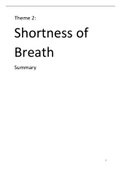Summary
Theme 2: Shortness of breath. A complete summary of all exam material!
- Course
- Institution
Upon recommendation of my fellow students, I now sell my summaries! In this summary, I use a lot of images, tables and enumerations. This means you don't have to read long pieces of boring and complicated text. This summary contains all the material of the books, lectures and learning objectives. T...
[Show more]



